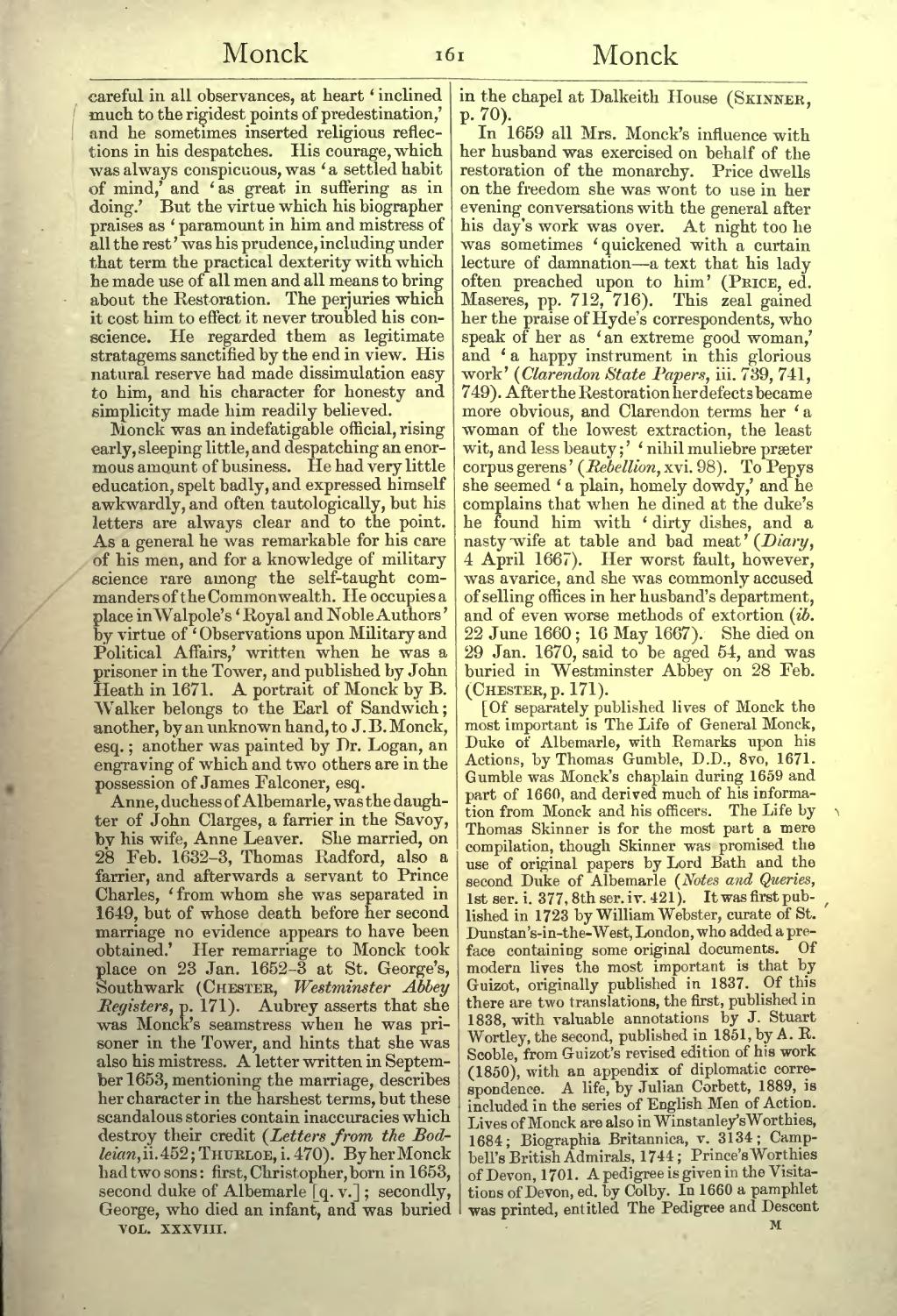careful in all observances, at heart 'inclined much to the rigidest points of predestination,' and he sometimes inserted religious reflections in his despatches. His courage, which was always conspicuous, was 'a settled habit of mind,' and 'as great in suffering as in doing.' But the virtue which his biographer praises as 'paramount in him and mistress of all the rest' was his prudence, including under that term the practical dexterity with which he made use of all men and all means to bring about the Restoration. The perjuries which it cost him to effect it never troubled his conscience. He regarded them as legitimate stratagems sanctified by the end in view. His natural reserve had made dissimulation easy to him, and his character for honesty and simplicity made him readily believed.
Monck was an indefatigable official, rising early, sleeping little, and despatching an enormous amount of business. He had very little education, spelt badly, and expressed himself awkwardly, and often tautologically, but his letters are always clear and to the point. As a general he was remarkable for his care of his men, and for a knowledge of military science rare among the self-taught commanders of the Commonwealth. He occupies a place in Walpole's 'Royal and Noble Authors' by virtue of 'Observations upon Military and Political Affairs,' written when he was a prisoner in the Tower, and published by John Heath in 1671. A portrait of Monck by B. Walker belongs to the Earl of Sandwich ; another, by an unknown hand, to J. B. Monck, esq. ; another was painted by Dr. Logan, an engraving of which and two others are in the possession of James Falconer, esq.
Anne, duchess of Albemarle, was the daughter of John Clarges, a farrier in the Savoy, by his wife, Anne Leaver. She married, on 28 Feb. 1632-3, Thomas Radford, also a farrier, and afterwards a servant to Prince Charles, from whom she was separated in 1649, but of whose death before her second marriage no evidence appears to have been obtained.' Her remarriage to Monck took place on 23 Jan. 1652-3 at St. George's, Southwark (Chester, Westminster Abbey Registers, p. 171). Aubrey asserts that she was Monck's seamstress when he was prisoner in the Tower, and hints that she was also his mistress. A letter written in September 1653, mentioning the marriage, describes her character in the harshest terms, but these scandalous stories contain inaccuracies which destroy their credit (Letters from the Bodelian, ii. 452; Thurloe, i. 470). By her Monck had two sons: first, Christopher, born in 1653, second duke of Albemarle [q. v.] ; secondly, George, who died an infant, and was buried in the chapel at Dalkeith House (Skinner, p. 70). In 1659 all Mrs. Monck's influence with her husband was exercised on behalf of the restoration of the monarchy. Price dwells on the freedom she was wont to use in her evening conversations with the general after his day's work was over. At night too he was sometimes 'quickened with a curtain lecture of damnation a text that his lady often preached upon to him' (Price, ed. Maseres, pp. 712, 716). This zeal gained her the praise of Hyde's correspondents, who speak of her as 'an extreme good woman,' and 'a happy instrument in this glorious work' (Clarendon State Papers, iii. 739, 741, 749). After the Restoration her defects became more obvious, and Clarendon terms her 'a woman of the lowest extraction, the least wit, and less beauty;' 'i nihil muliebre praeter corpus gerens' (Rebellion, xvi. 98). To Pepys she seemed 'a plain, homely dowdy,' and he complains that when he dined at the duke's he found him with ' dirty dishes, and a nasty wife at table and bad meat' (Diary, 4 April 1667). Her worst fault, however, was avarice, and she was commonly accused of selling offices in her husband's department, and of even worse methods of extortion (ib. 22 June 1660 ; 16 May 1667). She died on 29 Jan. 1670, said to be aged 54, and was buried in Westminster Abbey on 28 Feb. (Chester, p. 171).
[Of separately published lives of Monck the most important is The Life of General Monck, Duke of Albemarle, with Remarks upon his Actions, by Thomas Grumble, D.D., 8vo, 1671. Gumble was Monck's chaplain during 1659 and part of 1660, and derived much of his information from Monck and his officers. The Life by Thomas Skinner is for the most part a mere compilation, though Skinner was promised the use of original papers by Lord Bath and the second Duke of Albemarle (Notes and Queries, 1st ser. i. 377, 8th ser.iv. 421). It was first published in 1723 by William Webster, curate of St. Dunstan's-in-the-West, London, who added a preface containing some original documents. Of modern lives the most important is that by Guizot, originally published in 1837. Of this there are two translations, the first, published in 1838, with valuable annotations by J. Stuart Wortley, the second, published in 1851, by A. R. Scoble, from G-uizot's revised edition of his work (1850), with an appendix of diplomatic correspondence. A life, by Julian Corbett, 1889, is included in the series of English Men of Action. Lives of Monck are also in Winstanley's Worthies, 1684; Biographia Britannica, v. 3134; Campbell's British Admirals, 1744 ; Prince's Worthies of Devon, 1701. A pedigree is given in the Visitations of Devon, ed. by Colby. In 1660 a pamphlet was printed, entitled The Pedigree and Descent
